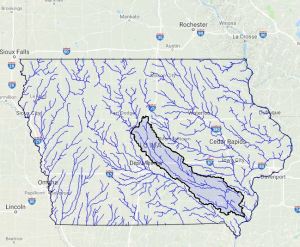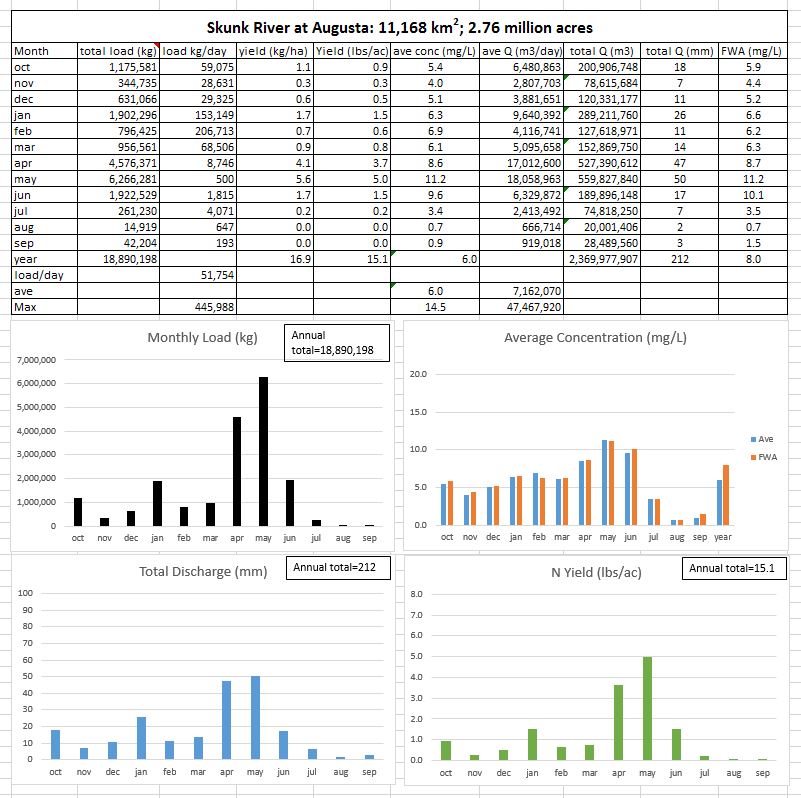Over the next few weeks I am going to post 2017 nitrate data summaries for many Iowa watersheds. These summaries are an aggregation of IIHR and USGS water quality sensor data, Iowa DNR ambient monitoring data, and USGS discharge data. Most of this data is in the metric system, sorry if that isn’t your thing. A key to some of the terms and abbreviations:
Load: total mass of a pollutant transported by a stream over a defined period of time. This is shown in kilograms (kg) in the data below.
Discharge (Q): total amount of stream water traveling past a defined point. This is shown cubic meters per day (m3/day) and millimeters (mm) below. I calculate discharge in mm by dividing the total water volume by the watershed area. This is a convenient way to look at discharge because you can compare it with precipitation in the same units. We also call this method of looking at discharge water yield.
Precipitation (P): average of all the Iowa State Mesonet weather stations in the watershed. I report this in mm.
Q/P: discharge to precipitation ratio. This oftentimes is an important driver for water quality.
Concentration: mass of a pollutant per unit volume of water. I report this as milligrams per liter (mg/L) which is the same as parts per million. My monthly average concentrations are derived from daily averages. For the sensor data, there are 288 measurements per day.
Flow weighted average (FWA) concentration. This is the total load divided by the total discharge. So this is not a daily or monthly average per se, but imagine if we were able to collect in a container all the river water over a defined time period (month or year) and then measure the nitrate concentration in that huge sample. That is FWA. For nitrate, this is oftentimes higher than the regular average over the course of a year.
N yield: this is the load of nitrate per unit area. I deviate from the metric system here and report this value in pounds per acre in the graphs.
Finally, I am reporting this data for the 2017 Water Year, which ran from Oct 1, 2016 to Sep 30, 2017. This is a common way that scientists look at stream data.
This report is for the Skunk River at Augusta. The Skunk drains 2.76 million acres, most of which lies in the Southern Iowa Drift Plain. There are two major branches (South and North) with the South being the longer and larger. Headwater areas of South Skunk north of Ames down to near Colfax are draining the Des Moines Lobe, which was glaciated only 12,000 years ago. Prior to European settlement, this area was dominated by wet prairie and wetland ecosystems. Downstream from Colfax the South Skunk is draining the Southern Iowa Drift Plain. The North Skunk travels through this landform as well. The two branches meet southeast of Sigourney, and the combined flow enters the Mississippi between Burlington and Fort Madison. The watershed is long and narrow and there are not many large tributaries, with Squaw Creek, Indian Creek, and Cedar Creek being the largest.

The South Skunk travels 185 miles, the North Skunk 129 miles, and Skunk 93 miles; thus from the headwaters of the South Skunk to the Mississippi is 278 miles.
The river’s name is probably the result of a European misinterpretation of the Sac and Fox word for onion or onion smell, as wild onions once grew in the upper reaches.
Approximately 62% of the land area is in corn and soybean production. Of Iowa’s major interior rivers, the Skunk is likely the most-affected by point source discharges, especially the areas from Colfax to Ames.
Water quality data are shown below. You can see the total nitrate-nitrogen load for the water year was about 18.9 million kilograms.
